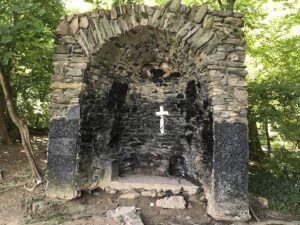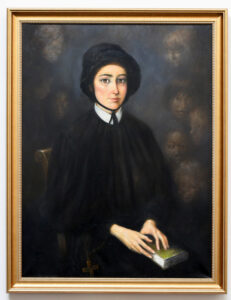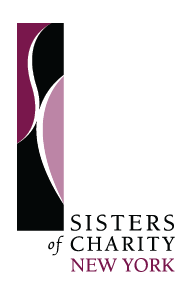by Sister Eileen McGrory
I like to explore – find places I’ve read about in the paper or sites that are part of the history of the Sisters of Charity of New York. During a week in August, both opportunities happened together for me.

Breakfast with a friend on a “staycation” morning put me in a neighborhood I had considered exploring. The local paper, The Riverdale Press, had carried a recent article on a grotto found in Seton Park and the interest of some people to restore the grotto. It had been part of Seton Hospital which the Sisters of Charity of New York opened in the Spuyten Duyvil area of the Bronx in 1894 to care for tuberculosis patients. The hospital had been named to honor the founder of the Congregation, Elizabeth Ann Seton. In May 1948, the Sisters turned the hospital over to the City of New York and, seven years later, in May 1955, the City closed the facility. In the mid-1970s, the land was developed as a recreational area and dedicated as Seton Park to remember the site and service of the hospital.
Since I found myself in the general area of West 234 Street and Independence Avenue which a map put as the location of Seton Park, I went off to find it and, hopefully, the grotto. Finding the park was easy; the grotto was, as the newspaper said, behind the present-day tennis courts. A short walk into the brush and I stood confronted by the evidence of our Congregation’s presence and service in this area well over one hundred years ago. It was easy to imagine that a statue of Mary graced this well-constructed stone alcove and to think of the sisters, staff, and family members who prayed before it for the return to health of loved ones. Here I was standing in a place that held the faith and hope of hundreds during the sixty-year history of the hospital.

But the wonders of the day’s exploration weren’t over! Life had more to say.
Thinking of the story of our history that once stood in this corner of the Bronx, I was drawn to roam through the whole park. As I passed for a second time an older couple on a bench minding two small children, something moved me to stop and talk to them. I told them who I was and why I was there, that the park was named for a hospital that our sisters built on this land 127 years ago, and that the park and hospital had the name of our founder, Elizabeth Ann Seton.
And then the gentleman surprised me with the intersection of his history with Saint Elizabeth Ann Seton! His mother had worked for the artist, Joseph Dawley, who had been commissioned to create paintings of Elizabeth Ann Seton for her canonization ceremony in 1975. After the surprise and serendipity of the moment paused the three of us, I was able to tell him that the four portraits the artist created were now in the Archives of the Sisters of Charity of New York, just a little over a mile away.
As I left the park, I turned to look back at it and, with a full heart, embraced all its told and untold stories of lives of love lived here in time.
August 2021

Great story. Thanks, Eileen.
I remember the grotto but had forgotten about it until I saw your write up . Thank you very much fora history lesson I was also taught by the sisters of charity at St. Gabriel’s school/parish.
Thank you for sharing this experience with us. I had no idea the Sisters had a hospital in that area. Isn’t it nice the area still reflects the calm and peace of Saint Elizabeth Ann Seton, and all the women who followed her lead. Rita Conyers
Very interesting
I was recently in Seton Park. It is a well used recreation space for which I am grateful that it continues to “keep on giving”. Eileen, thank you for sharing your feelings and thoughts and the story of the happy “encounter”. It is a small world.
Are you related to Anne McGrory who went to Cardinal Spellman HS?